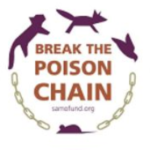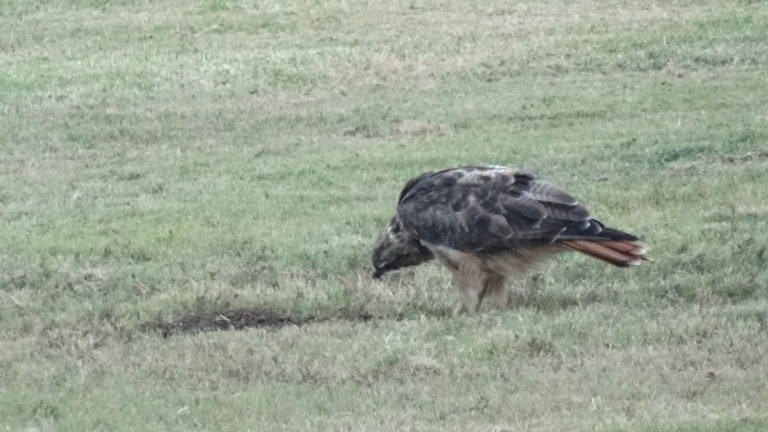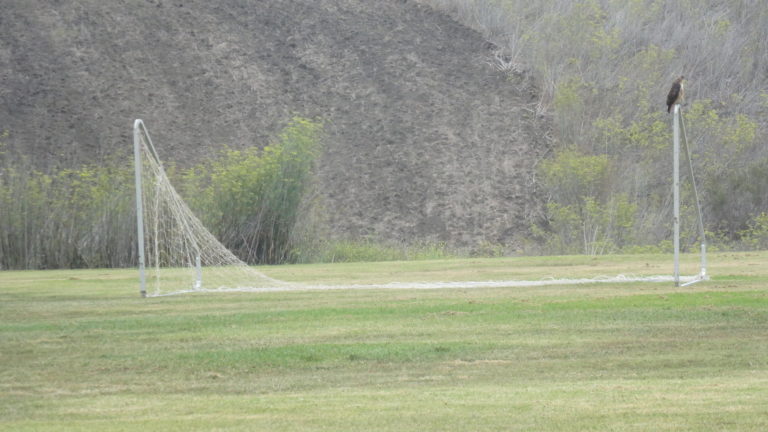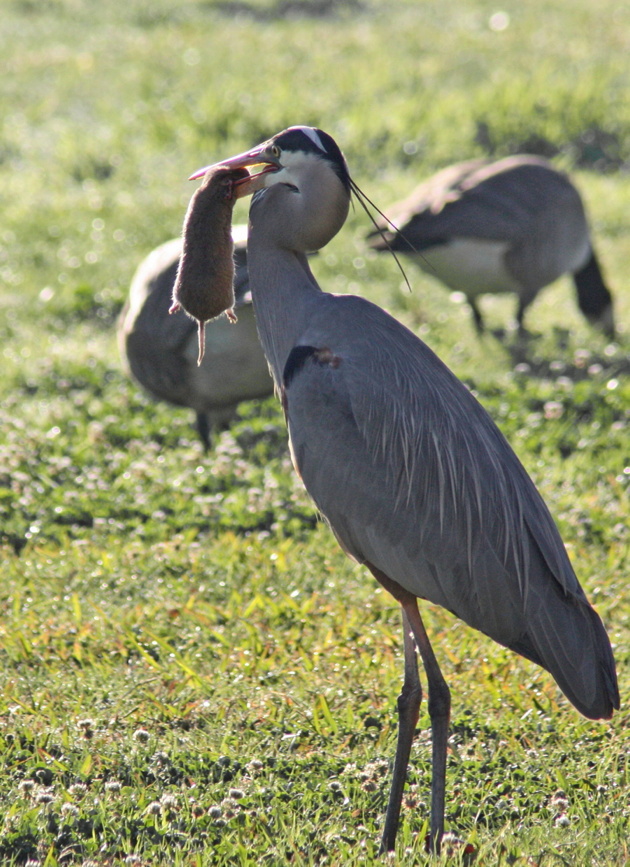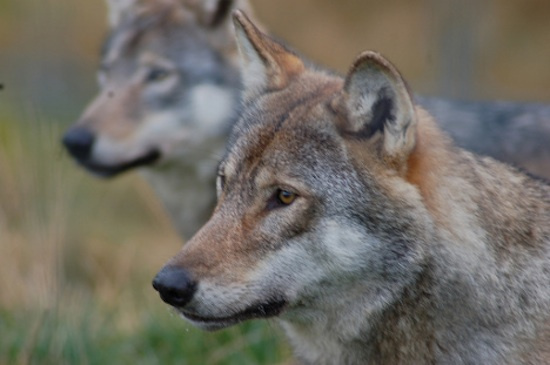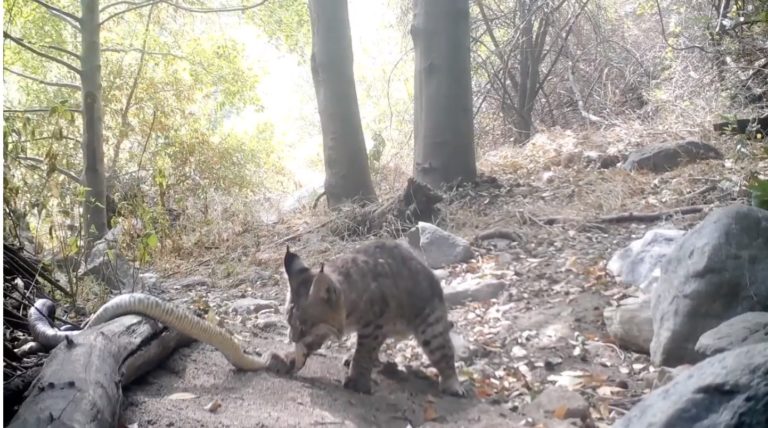Mountain Lions
Mountain lions (Puma concolor), also known as cougars, catamounts, pumas, and panthers provide vital ecological services that can improve habitat quality and sustain biodiversity. By regulating the behavior and abundance of their prey, mountain lions can mitigate negative consequences associated with ungulate and smaller predator population explosions. Additionally, mountain lion prey carcasses serve as nutrient inputs for other mammals, birds, reptiles, amphibians, insects, and even regenerate soils.
Mountain lions specialize in hunting deer, but are also known to have a somewhat flexible carnivorous diet: they can consume smaller predators and other hooved animals, which rarely include domestic dogs, cats, and livestock species. Cougars prefer to avoid humans at all costs at the population level but some individuals may come into contact with people and occasionally visit our neighborhoods because they are following their preferred prey, deer, as they seek refuge in suburban oases which provide shelter, shade, and food for them.
California’s Central Coast and Southern mountain lion populations were listed as candidate species under California’s Endangered Species Act in 2020, meaning that they have special protections during their candidacy.
- Prune shrubs and trees that provide cover for ambush hunting, a cougar specialty.
- Incorporate plants that repel deer into your landscaping.
- Seal crawl spaces under buildings in porches that cougars and other species may use for shelter.
- Haze cougars by making loud noises and acting assertively if one approaches.
- Use specially trained livestock guard animals.
- If you keep livestock, make sure their enclosures are properly secured with predator-proof fencing.
- In some cases, electric fencing might be appropriate.
- Nonprofit organizations dedicated to conserving endangered cougars are here to help you ensure your animals are safe.
- Here are some DIY predator-proof enclosure designs:
- NEVER FEED WILDLIFE as it attracts wildlife interactions including predation to your doorstep
- Keep garbage cans, dumpsters, and compost piles properly sanitized and secured.
- Do not make food, water, or shelter available near your home to discourage cougar residency.
- Supervise small children outdoors especially around dawn and dusk, if a cougar approaches haze it.
- Keep dogs and cats and their food indoors and supervise them outdoors. Prioritize keeping them secure at dawn and dusk if you keep your animals outdoors.
Mountain lions (Puma concolor), also known as cougars, catamounts, pumas, and panthers provide vital ecological services that can improve habitat quality and sustain biodiversity. By regulating the behavior and abundance of their prey, mountain lions can mitigate negative consequences associated with ungulate and smaller predator population explosions. Additionally, mountain lion prey carcasses serve as nutrient inputs for other mammals, birds, reptiles, amphibians, insects, and even regenerate soils.
Mountain lions specialize in hunting deer, but are also known to have a somewhat flexible carnivorous diet: they can consume smaller predators and other hooved animals, which include domestic dog, cat, and livestock species. Cougars prefer to avoid humans at all costs at the population level but some individuals may come into contact with people and occasionally visit our neighborhoods because they are following their preferred prey, deer, as they seek refuge in suburban oases which provide shelter, shade, and food for them.
California’s Central Coast and Southern mountain lion populations were listed as candidate species under California’s Endangered Species Act in 2020, meaning that they have special protections during their candidacy.
SoCal Cougars Face the Threat of Extinction...

"Our Human-Cougar Conflict Task Force is conducting work on-the-ground to intervene, directly assist, and empower local communities through training and education before and after human-cougar conflicts occur. The Task Force collaborates across multiple agencies, with local scientists, and with a coalition of organizations in order to achieve effective and long-lasting conflict resolution.
Our Services
Conflict Prevention Visits
Post-Conflict Visits
Cougar-Proof Enclosures
Hands-On Training
Technical Assistance
Our team provides expert advice on the available conflict prevention measures as well as the efficacy of such tools, based on the property and specific geographic area. Community members are given site-specific recommendations for reducing human-cougar conflict in their backyard or neighborhood. Our team assists communities with hands-on training and technical assistance such as cougar-proof enclosures."
Our Services
Conflict Prevention Visits
Post-Conflict Visits
Cougar-Proof Enclosures
Hands-On Training
Technical Assistance
Our team provides expert advice on the available conflict prevention measures as well as the efficacy of such tools, based on the property and specific geographic area. Community members are given site-specific recommendations for reducing human-cougar conflict in their backyard or neighborhood. Our team assists communities with hands-on training and technical assistance such as cougar-proof enclosures."
Korinna Domingo
Cougar Conservancy
Coyotes
The coyote (Canis latrans), a member of the dog family, is native to California. It closely resembles a small German shepherd dog with the exception of the long snout and bushy, black-tipped tail. The coyote’s high-pitched, yodel-like yapping can frequently be heard at night. Coyotes are an important part of the ecosystems they inhabit and they help to keep rodent populations in check. The Latin name for coyotes is Canis latrans, which translates to “barking dog.”
They are extremely adaptive in both their diet and geographical distribution. They will eat just about anything, and can live in many places including large urban centers, such as Los Angeles. Coyote diet consists mainly of native fruits and small mammals such as rabbits, woodrats, and mice.
Coyotes are usually fearful and cautious around people. They are typically most active between dusk and dawn, but they can be seen any time of day or night. Coyotes have been “clocked” running short distances at speeds of up to 40 MPH. Most coyotes can easily jump a 6 foot fence. Coyotes are monogamous, living their lifetime with one mate.
In the Santa Monica Mountains after car collisions, rat poison is the number one cause of death.
For more information, contact Project Coyote.
- If you see a coyote in your yard or neighborhood ALWAYS haze them away.
- Use a whistle or mini-horns.
- Fill a soda can with some coins or nuts & bolts and shake it to use as a noise-maker.
- If walking, put your dog on a leash, if they aren’t already. Do NOT turn your dog loose to go after the coyote.
- Raise your hands above your head, wave and make noise to shoo them away. Shout, clap your hands, shake your keys.
- You can buy and install rollers for the top of your yard fence to help keep coyotes and other animals out, as well as your dogs and (possibly) cats.
- You can also make yourself DIY fence-top rollers.
- Rollers are less likely to keep coyotes out of your yard if your fence is shorter than 6 feet tall.
- If you have chickens, rodent proof your chicken coop with stainless steel wiring. They will be attracted to backyard chickens and to the rodents that are attracted to the chicken feed.
- NEVER intentionally feed a coyote.
- Don’t keep pet food outside.
- Clean your grill after using, or store it inside your garage when not in use.
- Securely cover your trash and recycling cans. If possible and practical, put your trash out the morning of pick-up, rather than the evening before.
- Don’t add meat, bones, etc., to your compost pile.
- Ensure your compost bin is tightly and securely covered.
- Pick up fallen fruit.
- Keep cats indoors. Always is the safest, but at least between the dusk and dawn hours when coyotes tend to be most active.
- Don’t leave any dog tied up outside, small or large. When tied up, it is no match for a coyote and is enticing to them.
The coyote (Canis latrans), a member of the dog family, is native to California. It closely resembles a small German shepherd dog with the exception of the long snout and bushy, black-tipped tail. The coyote’s high-pitched, yodel-like yapping can frequently be heard at night. Coyotes are an important part of the ecosystems they inhabit and they help to keep rodent populations in check. The Latin name for coyotes is Canis latrans, which translates to “barking dog.”
They are extremely adaptive in both their diet and geographical distribution. They will eat just about anything, and can live in many places including large urban centers, such as Los Angeles. Coyote diet consists mainly of native fruits and small mammals such as rabbits, woodrats, and mice.
Coyotes are usually fearful and cautious around people. They are typically most active between dusk and dawn, but they can be seen any time of day or night. Coyotes have been “clocked” running short distances at speeds of up to 40 MPH. Most coyotes can easily jump a 6 foot fence. Coyotes are monogamous, living their lifetime with one mate.
In the Santa Monica Mountains after car collisions, rat poison is the number one cause of death.
For more information, contact Project Coyote.
- If you see a coyote in your yard or neighborhood ALWAYS haze them away.
- Use a whistle or mini-horns.
- Fill a soda can with some coins or nuts & bolts and shake it to use as a noise-maker.
- If walking, put your dog on a leash, if they aren’t already. Do NOT turn your dog loose to go after the coyote.
- Raise your hands above your head, wave and make noise to shoo them away. Shout, clap your hands, shake your keys.
- You can buy and install rollers for the top of your yard fence to help keep coyotes and other animals out, as well as your dogs and (possibly) cats.
- You can also make yourself DIY fence-top rollers.
- Rollers are less likely to keep coyotes out of your yard if your fence is shorter than 6 feet tall.
- If you have chickens, rodent proof your chicken coop with stainless steel wiring. They will be attracted to backyard chickens and to the rodents that are attracted to the chicken feed.
- NEVER intentionally feed a coyote.
- Don’t keep pet food outside.
- Clean your grill after using, or store it inside your garage when not in use.
- Securely cover your trash and recycling cans. If possible and practical, put your trash out the morning of pick-up, rather than the evening before.
- Don’t add meat, bones, etc., to your compost pile.
- Ensure your compost bin is tightly and securely covered.
- Pick up fallen fruit.
- Keep cats indoors. Always is the safest, but at least between the dusk and dawn hours when coyotes tend to be most active.
- Don’t leave any dog tied up outside, small or large. When tied up, it is no match for a coyote and is enticing to them.
Skunks
Skunks are nocturnal animals that are naturally mild-mannered and non-aggressive; they prefer small animals and insects for dinner instead of your garden.
The skunk claims homesteading rights from coast to coast. Distributed across the country are 4 species of skunks, including the striped skunk (Mephitis mephitis) and the spotted skunk (Spilogale putorius). The common striped skunk lives mostly in sparse forests and fields.
Skunks can be very nice to have around because they dig up and feed on the larvae of termites, wasps, hornets,maggots, cockroaches, cut worms, Japanese beetles, and other insects.
They also eat, rats, mice, moles and snakes!
However, they also may disturb your plants while digging for these grubs. This is what can make them a bit of a nuisance to gardeners.
A skunk’s warfare is purely defensive. When confronted by a menacing human or clamorous dog, skunks will try to sidestep by ambling off. This means that if you find a skunk, simply turn back and you should be fine. If pursued, skunks will turn, face their aggressor, and stamp their forefeet. This is their first warning. At this point, you should really be running!
The second warning comes when their tails, all but the tips, are hoisted. Then, this ultimatum failing to establish peace, the white tip rises, and spreads out, and the skunk, snapping into a U-position with snout and rear toward the target, delivers a charge of spray. At this point, it is simply too late.
A seasoned veterinarian shared with me his favorite pets were two skunks that cuddled close to him every night in bed. However, presently skunks are considered to be wild animals in California we are not allowed to have them as pets anymore.
WHAT TO DO IF YOU GET SPRAYED BY A SKUNK
If you or your pet gets sprayed by a skunk, try a mixture of 1 quart 3 percent hydrogen peroxide, ¼ cup of baking soda, and 1 to 2 teaspoons of liquid dish soap. Shampoo only the area sprayed by the skunk. Wet the area and work the solution into the skin or fur with your hands (avoid the eyes). Rinse well.
If you have any special remedies that you use, let us know.
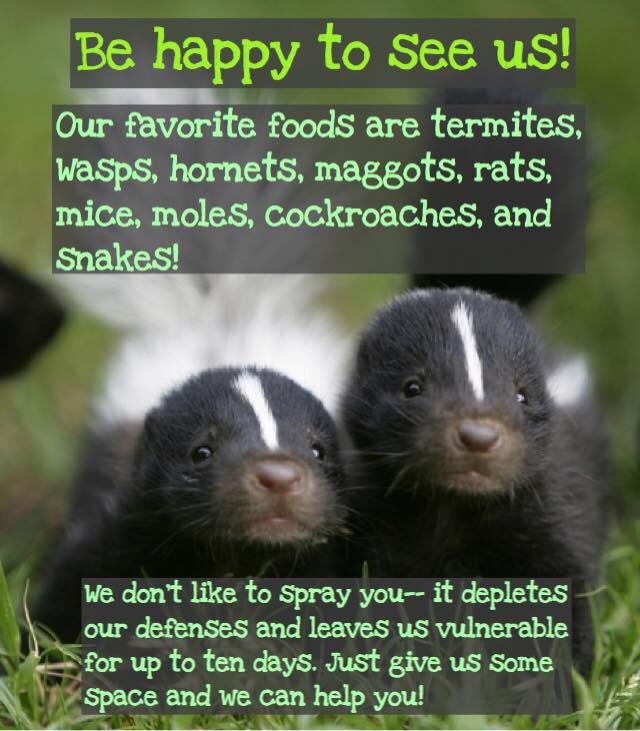
• One of the best skunk repellents is a light. Skunks are nocturnal and their eyes are very light sensitive. A bright light or a motion sensor flood light will scare skunks away. An example is Predator Guard’s Solar LED Deterrent Lights
• Spray a mixture of castor oil diluted in water.
• Place orange or lemon peels around the yard.
• Predator urine (cats) can be used – please use only biodegradable kitty litter. It is better for the environment AND your cats health.
• Place ammonia-soaked rags around the yard. Watch that you do not place these on any green vegetation as it will kill it.
• If the skunks are in a smaller garden patch, put bars of strong smelling soap or a room deodorizer near your garden. Ironically, skunks hate strong scents.
• If skunks are snacking on the vegetables in your garden you can plant cucumbers, squash or other prickly-leaved plants among your vegetables.
• Cayenne pepper and other hot pepper solutions may be effective, however they pose a threat to children and pets who come into contact with them.
• Fencing may also be a good idea for small areas, such as a garden patch.
• If you don’t want skunks living under your deck or shed, seal these areas with hardware cloth. Leave at least one foot of additional wire in the ground extending from the structure to prevent skunks from digging under.
• As skunks love to find lots of grubs in your garden, one of the best preventative methods is to treat your lawn so that you get rid of their favorite snacks. Spray your lawn with beneficial nematodes. This will also help to control Japanese beetle larvae.
• Put your pet food away
• Remove birdfeeders at night
• Make sure your trash cans have tight-fitting lids, and don’t leave any trash bags by your door.
• Secure your compost pile
• Remove piles of wood, or junk so that they can’t build a den in them.
Raccoons
The common raccoon is a medium-sized mammal native to North America. It is the largest of the procyonid family. Its grayish coat mostly consists of dense underfur which insulates it against cold weather. Three of the raccoon’s most distinctive features are its extremely dexterous front paws, its facial mask, and its ringed tail, which are themes in the mythologies of the indigenous peoples of the Americas relating to the animal. The raccoon is noted for its intelligence, as studies show that it is able to remember the solution to tasks for at least three years. It is usually nocturnal and omnivorous, eating about 40% invertebrates, 33% plants, and 27% vertebrates including mice!
Raccoons give birth from January through June and often use attics and chimneys as dens to raise their young. If you discover a family of raccoons nesting in or around your home, the animals should not be removed until fall (when nesting season has ended) in order to avoid separating young raccoons from their parents. It is inhumane to let the little ones starve to death, and the mother will also try frantically to reach her young and could damage your property in the process. Young raccoons do not venture out of the nest until they are 8 to 9 weeks of age. Trapping and moving the family is not recommended because it will almost certainly separate the mother from her young. Furthermore, relocating solitary raccoons or small raccoon families is illegal in most places and will likely result in their being mauled and killed by resident raccoons.
When you’re certain that the young raccoons have left the nest, frightening devices, such as a portable radio or a mechanic’s light, can be used to evict the animals. Making the area as smelly as possible by placing a few ammonia-soaked rags, is a very useful deterrent. Because raccoons are nocturnal animals, evicting them is easiest around dusk when they begin their nightly routines. Storms, dogs barking, or other atypical outdoor disturbances can delay eviction. If raccoons must be evicted during nesting season for safety reasons, it can take several days for a mother to move babies to a new nest once humane deterrents are in place.
Once you are certain that the raccoons have left, carefully inspect the area for animals before installing exclusion devices. Install a chimney cap and repair and seal openings. Never use smoke or fire to drive animals out of chimneys. This will almost certainly kill young animals who are not physically able to leave on their own—whether they be raccoons, squirrels, opossums, or birds. Once areas are sealed, watch and listen for signs that young animals have been trapped inside, including young animals crying out or moving inside walls or fixtures, mothers pacing in the vicinity, or mothers scratching, chewing, or pawing at the area. If you discover that young animals have been sealed inside, reopen the sealed area immediately so that the mother can attend to her young.
If for some reason you find an adult raccoon in your home after you seal off points of entry, remain calm. If left alone, raccoons will not cause any harm. The best thing to do is to close openings providing access to other parts of the house, open windows and doors through which the raccoon can exit, and then wait quietly for the animal to escape.
Once the raccoons have been evicted, you should not attempt to trap and remove raccoons from the property. Trapping and removing them will do nothing for long-term control, as the newly vacant niche will quickly be filled by raccoons from surrounding areas. Relocating raccoons—even to wild or wooded areas—is illegal in many places and will likely result in their death.

Coffee Grounds
Use grinds from scented flavors of coffee. Sprinkle generously in areas of concern
Use Hot Stuff
A common DIY method is to make a mixture of spicy hot peppers (e.g. jalapeños) which can then be used as a spray around the house, around garbage bins, and near all possible points of entry.
1. Mix a bottle of hot sauce or cayenne pepper powder with a gallon of water.
2. Mix in a teaspoon of liquid dishwashing soap to help the mixture adhere.
3. Spray this stuff all around the perimeter of your property, garbage bins, entry points, or any other areas of interest.
Ammonia
Ammonia can be soaked into rags and applied to entry points or food sources. It can also be kept in small, open jars or bottles placed near food sources or around the bins.
Vinegar
Apple cider vinegar can be used similarly to ammonia.
Epsom Salts
Epsom salts not only serve as an excellent raccoon deterrent, they also make excellent fertilizers for your plants and garden. Scatter them around your bins and in your garden or make a spray
Recipe: Mix one cup of Epsom salts with five gallons of water and spray onto foliage.
Peppermint
Spray essential peppermint oil around periphery
Recipe: Mix 20 drops of essential oil to 1 quart of water
Plant garlic or spray garlic juice
Secure Garbage Bins
It is important to use a locking garbage bin or one with a close-fitting or heavy metal lid. If necessary, use bungee cords to seal it tight.
Secure Bird Feeders and Pet Food Dishes
Bring them in at night.
Secure compost bins
Restrict Entry Points
Seal all entry points to your home.
How to Evict Your Raccoon Roommates, video by National Geographic
Low voltage Electric Fencing
Care must be taken!
There is some risk if you have young children or pets.
Shut it off during the day.
Here is a supplier for a human-safe electric fence to keep out raccoons, rabbits, ground hogs, skunks and other pest animals of similar size
Motion Detection strobe light or water spray
Motion-detecting devices can be installed in the garden or areas where raccoons are likely to enter.
Raccoons are nocturnal, dislike light, and will turn tail at the sight of sudden, bright, flashing light.
Snakes
Snakes are an important part of our ecosystem in part because they naturally control rodent populations. Some snakes are venomous and others are not. The only venomous snake that we have in the Santa Monica Mountains is the Southern Pacific Rattlesnake. Southern California is known to have an estimated 33 native snake species. Out of these 33 species, only 7 are venomous, all varieties of rattlesnakes.
Rattlesnakes can be professionally relocated and then put up snake fencing to block further access.
Here is a company that wrangles and captures snakes, and puts up fencing:
http://www.rattlesnakewrangler.com
818-880-4269 (Home)
818-383-0476 (Cell)
Many people mistake rattlesnakes for non-venomous gopher snakes.
Gopher snakes are harmless and love to eat gophers!
Here’s more information.
You can even buy them – here.
Never Use Rodent Poisons!
Modern supertoxic rodent poisons are spreading throughout our ecosystems causing massive exposure, disease, and death beyond the intended targets. Current studies have proven that there are no safe poisons that can be used around wildlife, pets, and children. It is imperative that we do our part to stop the use of poisons to control rodents and to prevent these poisons from killing other species that feed on them and risking the lives of our children and pets.
Learn how you can help to break the poison chain through science-based policy reform:
Benefits of Predators
- Predators naturally regulate the populations of their prey, and many predators specialize on prey that we regard as unwanted guests such as rodents and deer.
- Explosions in prey populations can drastically alter ecosystems which can produce undesirable outcomes overbrowsing of vegetation.
- Regulation of prey populations can have cascading effects that improve habitat quality for other species, including butterflies!
- Predator species hold tremendous cultural value. They are iconic, sacred, and must be protected from extermination.
- Predators naturally regulate the populations of their prey, and many predators specialize on prey that we regard as unwanted guests such as rodents and deer.
- Explosions in prey populations can drastically alter ecosystems which can produce undesirable outcomes overbrowsing of vegetation.
- Regulation of prey populations can have cascading effects that improve habitat quality for other species, including butterflies!
- Predator species hold tremendous cultural value. They are iconic, sacred, and must be protected from extermination.
We Need Wolves and Other Top Predators for the Ecosystem
Click the photo to see the National Geographic video that demonstrates how all things are connected and learn about the beautiful chain reaction that happened when wolves were reintroduced to Yellowstone National Park.
How Wolves Changed Rivers


